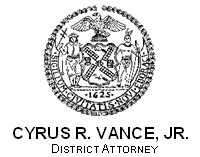

DA VANCE: STRUCTURE TONE, INC. CONVICTED OF FALSIFYING BUSINESS RECORDS ON MAJOR CONSTRUCTION JOBS
Earlier this week, Manhattan District Attorney Cyrus R. Vance, Jr., announced the conviction of STRUCTURE TONE, INC. (STI), a Manhattan-based company, for falsifying purchase orders with the intent to defraud their construction management clients. The company was charged with and pleaded guilty to Falsifying Business Records in the First Degree and will forfeit $55 million.
“Interiors construction is a multi-billion dollar industry in New York City and is vital to our city’s economy,” said District Attorney Vance. “Structure Tone’s felony plea and forfeiture of $55 million – one of the largest forfeitures ever imposed on a construction company – sends a clear message that this type of criminal activity will not be tolerated. This plea agreement addresses the severity of Structure Tone’s criminal conduct, while taking into consideration the remedial actions the company has implemented since 2010 to end the fraud and provide better oversight of its business practices. This is the Rackets Bureau’s third major case in this area since I became DA, and the industry should be on alert. We are rooting out fraud and making sure that honest businesses can compete fairly.”
Firms in the interiors construction industry focus on building the interiors of commercial and large residential buildings. STI is one of the largest interiors construction companies in New York City and performs projects for commercial clients, including banks, law firms, financial institutions, and advertising agencies. STI enters into two basic types of contractual relationships with its clients, acting as either a construction manager or as general contractor.
On a Construction Manager (CM) project, Structure Tone is hired by the client to oversee or “manage” a project. Under these contracts, STI is required to act in the best interests of the client, making certain that the client receives the best value for the money spent. In addition to paying for sub-contractors, the CM client also pays a percent-based management fee to Structure Tone (typically 3 percent of the overall contract value), a fixed fee for management of the entire project and, at times, other incentives. Other than its management fee for a particular subcontractor, there are no legitimate circumstances under which STI is entitled to additional profit based upon the subcontractors’ costs to the CM client.
On a General Contractor (GC) project, Structure Tone charges clients a lump sum, or fixed price. As a GC, STI is simply required to complete the client’s project to their specifications. STI’s profit is the difference between the agreed upon lump sum price of the contract and the actual cost incurred by STI to complete the project. The lower the costs of the work performed by the subcontractors, the more profit STI makes.
According to Structure Tone’s guilty plea and documents filed in court, between 2005 and 2009, the company, with the intent to defraud, falsified subcontractors’ purchase orders.
Here is how the practice worked:
• STI required the subcontractors on CM jobs to increase their bids by adding, in many cases, unnecessary contingencies listed in an addendum provided by STI called the Rider B. This practice was concealed from the CM clients.
• Once the CM clients agreed to pay the subcontractors’ increased bids, STI also procured additional discounts and savings from these subcontractors that were not passed along to the clients.
• STI then created fraudulent purchase orders containing these increased amounts (from the Rider B) and omitting any discounts provided by subcontractors – in many cases caused the CM clients to overpay. The subcontractors held these overpayment amounts for STI.
• STI recovered these overpayment amounts by inducing these same subcontractors to provide discounts to STI on other, unrelated GC projects.
This case was a joint investigation by the Manhattan District Attorney’s Rackets Bureau and a detail of the Special Investigations Unit of the New York State Police assigned to the Rackets Bureau. The plea and sentence announced today is the result of ongoing investigations by the Manhattan DA’s Office into fraud and corruption in the New York City construction industry. Over the past six years, the Manhattan DA’s Office has obtained more than 40 convictions from scores of individuals and corporations, including some of the largest general contractors in New York City, for kickbacks and bid-rigging schemes, and recovered more than $50 million through those prosecutions.
Assistant District Attorney Christopher Beard, Senior Investigative Counsel, Assistant District Attorney Aaron Sato, and Assistant District Attorney Melissa Fox assigned to the Rackets Bureau, handled the prosecution of the case under the supervision of Assistant District Attorney Daniel Brownell, Chief of the Rackets Bureau and Deputy Chief of the Investigations Division, and Assistant District Attorney Michael Ohm, Deputy Bureau Chief of the Rackets Bureau. Principal Financial Investigator Michael Kelly and Trial Preparation Assistant Ra’anaa Samad assisted with the investigation.
Assistant District Attorney Duncan Levin, Chief of the Asset Forfeiture Unit, and Benjamin E. Rosenberg, General Counsel to the District Attorney’s Office, are handling the asset forfeiture portion of the case.
The District Attorney thanked the New York State Police for its assistance in the investigation, including Superintendent Joseph D’Amico, Special Investigation Unit Major Thomas G. Marmion, Lieutenant David Atkins, and Investigators Gary Titus, Neil Anderson and Michael Rhoads, under the supervision of Senior Investigator Gustav Talleur.
Defendant Information:
STRUCTURE TONE, INC.
New York, NY
Convicted:
• Falsifying Business Records in the First Degree, a class E felony, 1 count
